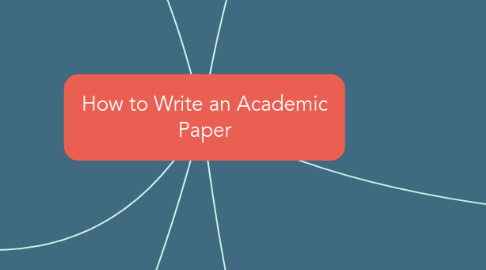How to Write an Academic Paper
por Montana Hermenau


1. A Strong Thesis Statement
1.1. "A thesis is an interpretation of a question of subject" (University of North Carolina College of Arts and Science, 2018, para. 3) this is to create a pinpoint thought or argument on a topic
1.2. have your professor review the rough draft version of your thesis
1.3. Connect your specific argument to a bigger picture, to avoid the "so what?" (University of North Carolina College of Arts and Science, 2018, para. 8) statement.
1.4. Is there a direct correlation between the facts stated and your thesis? As in, there is a linear connection between what fact is being presented and your argument stated.
2. What constitutes a good conclusion (University of North Carolina College of Art and Science, 2016)
2.1. This is a location of the paper to write your final statements.
2.2. Not having the conclusion as a solitary ending point, but as a machine to create new thought process in a positive outlook.
2.3. "Play the so what? game" with your topic until you've reached why you need to elaborate on this topic.
2.4. Instead of restating your body paragraphs, put it into new words to avoid repetitiveness.
2.5. Allow your conclusion as a fulcrum into other critical thinking topics for the reader.
3. Refrences
3.1. The body of your paper. (n.d.). Powerwrite. Retrieved from http://facweb.furman.edu/~moakes/Powerwrite/body.htm
3.2. University of North Carolina College of Arts and Science. (2016). Conclusions - the writing center. Retrieved from https://writingcencter.unc.edu/handouts/conclusions/
3.3. University of North Carolina College of Arts and Science. (2016). Introductions- the writing center para. 3 and para. 7. Retrieved from https://writingcenter.unc.edu/handouts/introductions/
3.4. University of North Carolina College of Arts and Science. (2016). Thesis statements para. 3 and para. 8. Retrieved from https://writingcenter.unc.edu/handouts/thesis-statements/
3.5. University of New England (n.d.) Paragraphs: academic writing. Retrieved from https://www.une.edu.au/current-students/resources/academic-skills/fact-sheets
4. Creating a Well Rounded Introduction
4.1. Bridge the reader's mind into "your analysis" (University of North Carolina College of Arts and Science, 2016, para. 3) from their current realm.
4.2. Remember, introduction sets the stage for your audience.
4.3. Engage the reader into an "intellectual conversation" (University of North Carolina College of Arts and Science, 2016, para. 7).
4.4. Must include constructed thesis statement.
4.5. Conclude your writing of the paper with writing the introduction last.
4.5.1. Have a broad enough opening to engulf your reader, but make it specific enough to have a linear connection with stated argument.
4.6. Revise your introduction, if need be.
5. Elements of a Paragraph (University of New England, n.d.)
5.1. Outside information: quotes, data, and examples
5.2. Three different types of senteces
5.2.1. Topic: introduces an idea
5.2.2. Supportive: explains or strengthens topic
5.2.3. Concluding or Transitional: rewords topic sentences with supportive ideas or progresses the topic onto the next topic

